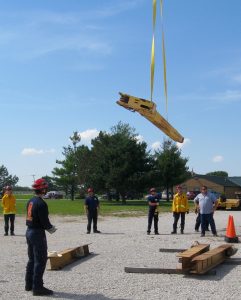
By CARL GREEN
Correspondent
Silex, MO – We hope it will never happen, but we also know that it could.
If a major attack or natural disaster were to hit somewhere in the St. Louis region, would we be prepared?
Operating Engineers Local 513 is doing its part to be ready, along with emergency workers from throughout the area. The Engineers have begun joining in rescue training with firefighters from area communities.
The big issue is communication. When some disaster has knocked down structures and people are trapped under the rubble, will the Operating Engineers running the construction equipment be able to communicate with the rescuers trying to get to the victims?
“These firemen are going to be out there and they’re going to try to rescue somebody, but that debris has got to be hoisted away,” said Pat Kammer, president and business manager of Local 513.
“They have to learn the hand signals that we use every day in our business so they can communicate with that crane operator. That’s exactly what we saw during 9-11. They had to learn really fast how to communicate. We’re trying to get ahead of the curve.”
TRAINING DAY
The Operating Engineers and rescuers took a big step toward being prepared for the next emergency on Friday, Sept. 23, when Local 513 hosted emergency workers from several St. Charles County communities for a day of training, following conversations between local members and firefighters.
Local 513’s training center on 240 acres near Silex in Lincoln County provided a perfect location, with its supplies of construction equipment, assorted debris and trained instructors.
Brian Gettemeier, a Cottleville firefighter, rescue instructor and one of the organizers of the event, said it couldn’t have been held anywhere else.
“They said, ‘We have the cranes, and we have the rubble.’ It’s an opportunity that our guys just wouldn’t get otherwise,” he said. “It’s great. We would have never been able to have an opportunity like this. They’re providing the instructors, the equipment and the props. All we had to do was drive up.
 “It’s going to pay huge dividends.”
“It’s going to pay huge dividends.”
Three groups of about eight rescuers cycled among three stations. At one, they worked with crane operators to remove huge chunks of concrete such as those you might find in a disaster scene. They learned to attach cables correctly and work with the crane operator to lift the pieces away safely.
At another, they trained with crane operators to remove a long, heavy metal piece that required some careful balancing work. At the third, they practiced using a welding torch to cut through metal beams.
A DIFFERENT WORLD
“They’re teaching us about cranes and rigging,” Gettemeier noted. “The way they usually pick up stuff, everything’s very clean and in a nice stack. But when we are out there, it’s kind of catty-wompas, with people underneath it. Our world is way different.”
Rescue workers typically go through about four hours of working with cranes in their training programs, he said.
“Today we’re going to double the amount of time our guys get on cranes,” he said.
To Pat Kammer, it was an opportunity for Local 513 to provide another service to the community.
“When earthquakes happen, what’s the first thing that comes in there but construction equipment to clear rubble so you can get to the survivors?” he said. “You want it to be a rescue mission; you don’t want it to be a recovery mission.”
 It was the second such training effort for the local. Participants came from fire departments in Wentzville, Cottleville and O’Fallon, MO, plus Central County Fire & Rescue in St. Peters. Kammer expects to provide more training days for emergency departments within the Local’s jurisdiction, the eastern half of Missouri.
It was the second such training effort for the local. Participants came from fire departments in Wentzville, Cottleville and O’Fallon, MO, plus Central County Fire & Rescue in St. Peters. Kammer expects to provide more training days for emergency departments within the Local’s jurisdiction, the eastern half of Missouri.
Tim Sappington, the Local 513 training administrator, said this kind of cross-training has been common in the East since 9-11 but is a newer development in the Midwest.
“Any time we can help them get trained, we will,” he said. “After all, they serve the public. They’re the ones who come and rescue us when there’s some kind of emergency situation. So if we can better prepare them, that’s good.”
TRAINING SCHOOL
The training school, funded by contractors and union members, is a state-of-the-art, indoor-outdoor complex with a 13,000-square foot main building, equipment, classrooms, sleeping rooms and a dining hall that provides a three-year apprenticeship program and upgrades.
Apprentices learn to operate cranes, backhoes, skid steers, high lifts, dozers, excavators, scrapers, compactors and forklifts, with training in hazardous waste removal, aerial lifts, welding, first aid-CPR, construction safety and more.
Brian Gettemeier said he appreciated Local 513’s willingness to help.
“When people need help, they call us, and when we need help to pick up the heavy stuff, we’re going to call them. So they’re our 911.”

